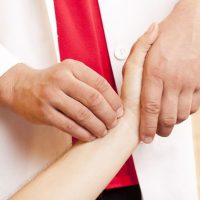Palpation
The truth about people is hard to know. There is much that they will not say, and much of what they say is only partly true. There is also much that people simply cannot say, because they themselves do not know, because many realities defy introspection… We may be sick, even, with no sense of sickness.(1)
There is no sense more certain than touch. Every treatment relies on palpable feedback from the body, first in assessing the condition, then in confirming the effect of treatment. Any point on the body can provide valuable information, but the primary tools in this practice are the pulses and the abdomen.

“Reading” the Pulses
Although reading the pulses is reputed to be very difficult, the work of a lifetime, it is also straightforward. If it is too rapid, there is heat of some kind, somewhere. If it is slow and weak, there is blockage or exhaustion. Of course, there are many other pulse qualities to consider, such as the shape of the wave in different finger positions and at different depths, the tone and width of the vessel, how it lies, and so on; but these also generally indicate something clearly. If the information sensed is not definitive, it is enough to frame a question which can usually be untangled in the course of treatment.
Best of all, the pulses have predictable responses to needling. Different points addressed with different techniques elicit a palpable change that confirms the validity of the treatment at every step. There is no guessing.
Abdominal Palpation
If pulse reading is straightforward, assessment by abdominal palpation is almost easy. Different areas reflect different internal functions. The soft tissue of the skin, muscle, adipose, and abdominal wall should be generally supple and firm, but not hard or tight. Variation in any direction is clear. The practitioner feels it objectively, the patient feels it subjectively, and both feel it change after needling the associated points. It is very helpful in building trust all around.
Combining these tools can provide an overview of a condition very quickly. If the pulse is slow and weak at first, but the diaphragm is tight and sore on pressing, then there is a blockage reducing the flow of blood where it is needed. One or two needles will usually cause the pulse to course freely, and the patient feels revitalized and relaxed. If the pulse is weak and the flesh is soft (regardless of fitness or weight), lacking buoyancy, then the body is really depleted. In that case, moxa improves things right away.
This fulfills the most basic rule of healing: “Where there is excess, drain it. Deficiency, tonify.”(2) Illness is complicated. Medicine is that which makes it simple again.
-
Kuriyama, Shigehisa. The Expressiveness of the Body and the Divergence of Greek and Chinese Medicine. 1999. p. 17.
-
Ling Shu 10.
